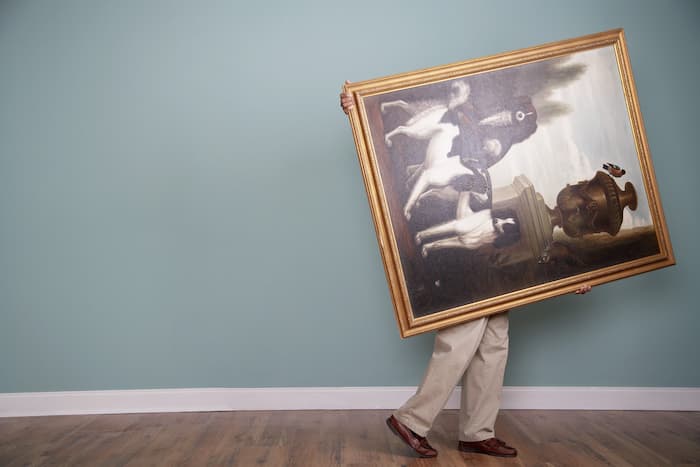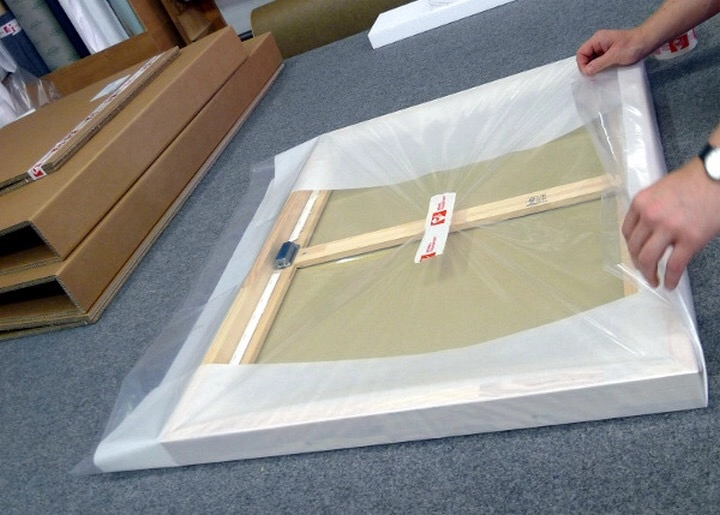A piece of artwork that you want to move to a new place without damaging it, presents you with a challenge.
It seems simple enough just take off the glass, bubble wrap, and styrofoam and rig up some belts to hold the artwork in place while you transport it but there are more things you’d have to do.
Getting a Moving Quote is simple. It's fast & easy
GET FREE QUOTE NOW
Whether you’re moving art across town or the country, you want to make sure it arrives at your destination scratch and bump-free. In this article, you will get all the tips you need on how to pack and transport artwork.
Artwork can either be wrapped or sealed in a plastic bag or unwrapped but then carefully padded on both sides with cardboard. If the artwork is fragile, like a glass jar or a vase, it needs to be wrapped to keep it from breaking. A few simple steps can ensure that moving your artwork doesn’t damage it and leave you with a sad story to tell.

Materials You Will Need
| Material That You Need | Purpose/How to Use | |
|---|---|---|
| Glassine Paper | Protects artwork from dust, moisture, and smudging. | |
| Acid-Free Tissue Paper | Provides a soft layer to prevent surface scratches. | |
| Bubble Wrap | Cushions the painting from impact and vibrations. | |
| Cardboard Corner Protectors | Shields frame corners from dents and chips. | |
| Foam Boards | Adds rigid protection to prevent bending or punctures. | |
| Packing Tape | Secures wrapping materials without damaging the artwork. | |
| Painter’s Tape | Used for securing glass and preventing shattering. | |
| Sturdy Cardboard Box (or Wooden Crate for Fragile Pieces) | Provides structural protection during transport. | |
| Plastic Wrap (Stretch Film) | Keeps protective layers in place and adds moisture resistance. | |
| Packing Peanuts or Foam Padding | Fills empty space in the box to prevent shifting. | |
| Gloves (Cotton or Nitrile) | Prevents oils and dirt from transferring onto the artwork. | |
| “Fragile” and “This Side Up” Labels | Ensures careful handling during transport. |
Packing Principles
Never wrap artworks for moving in plastic or polythene as it causes condensation.
You should use clean, white packing paper. This will ensure that any marks left on it do not transfer onto the artwork when being wrapped. If you cannot get hold of this, then use plain newsprint (the type of paper used for newspapers). Newspaper can leave ink marks so make sure there is a layer of plain paper between the artwork and the newspaper.
You can also use bubble wrap for additional protection; however, if you do use this then make sure that all bubbles are facing outwards towards another layer of wrapping material or cardboard so that none are touching the artwork itself.
If you have any cardboard from packing or boxes to hand then these can also be used for additional protection but again would need to be wrapped in at least one layer of clean paper or bubble wrap before being placed around the item.
Artworks with a protective glass surface, such as framed paintings, photographs, and prints should be wrapped in paper and placed into a container that is designed to hold flat items. Use containers that are of the same size as the artwork; this will reduce the amount of padding required.

Step by Step Guide on Wrapping Your Artwork
Start with clean hands, you don’t want to get dirt, oil, or other contaminants on the art when you’re wrapping it. If hanging, remove the picture from its frame. Take note of how it’s mounted so you can re-mount it correctly once you arrive at your new home. Then follow the steps below:
- Wrap the unframed art in a protective material such as cardboard, foam core, or bubble wrap.
- Put artwork in plastic bags or cover with plastic wrap before packing boxes. This will help protect against moisture.
- Tape the plastic bag shut or use tape to secure the plastic wrap to prevent dust from entering the wrapping and settling on the art surface.
- Use acid-free tissue paper to pad artwork before wrapping. Do not use newspapers, which can leave ink stains on art surfaces. Use white tissue paper to avoid dye transfer onto the artwork.
- Wrap framed art using glassine paper, brown craft paper, tissue paper, or plain newsprint before covering with cardboard or other strong material. It is best to put glassine on both sides of the glass if you are going to stack the art for long-distance moving (be sure to tape around the frame edges).
- Tape the frame glass in an X pattern, this will keep it from breaking into small shards if damaged.
Labelling of Paintings for Moving
✅ Use clear, bold labels – write ‘FRAGILE – HANDLE WITH CARE’ in large, bold letters on several sides of the package.
✅ Label ‘THIS WAY UP’ – put arrows to indicate the correct orientation of the painting.
✅ Include a brief description – write ‘Framed Painting’ or ‘Artwork on Canvas’ so movers know what’s inside.
✅ Add your contact information – if you use a moving company, include your name and phone number in case there are any problems.

Conclusion
Wrapping artwork for moving is not an easy task for someone doing it for the first time. They require special and delicate attention to ensure they are adequately protected from the many dangers and challenges that can occur while they are being moved to your new home. Many artists have spent a lot of money on their artwork and take great pride in their collections and the same applies to those that buy from them.
So, if you don’t want to inflict any damage to your paintings, sculptures, or other such treasured possessions before or during a move, you need to be careful about how you pack them.


